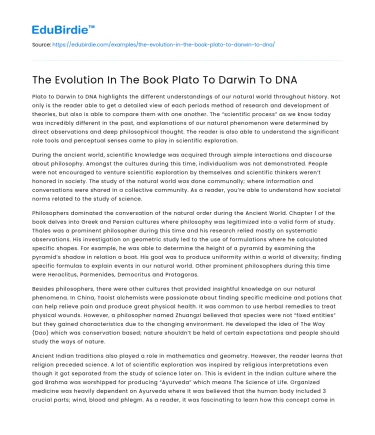Plato to Darwin to DNA highlights the different understandings of our natural world throughout history. Not only is the reader able to get a detailed view of each periods method of research and development of theories, but also is able to compare them with one another. The “scientific process” as we know today was incredibly different in the past, and explanations of our natural phenomenon were determined by direct observations and deep philosophical thought. The reader is also able to understand the significant role tools and perceptual senses came to play in scientific exploration.
During the ancient world, scientific knowledge was acquired through simple interactions and discourse about philosophy. Amongst the cultures during this time, individualism was not demonstrated. People were not encouraged to venture scientific exploration by themselves and scientific thinkers weren’t honored in society. The study of the natural world was done communally; where information and conversations were shared in a collective community. As a reader, you’re able to understand how societal norms related to the study of science.
Save your time!
We can take care of your essay
- Proper editing and formatting
- Free revision, title page, and bibliography
- Flexible prices and money-back guarantee
Philosophers dominated the conversation of the natural order during the Ancient World. Chapter 1 of the book delves into Greek and Persian cultures where philosophy was legitimized into a valid form of study. Thales was a prominent philosopher during this time and his research relied mostly on systematic observations. His investigation on geometric study led to the use of formulations where he calculated specific shapes. For example, he was able to determine the height of a pyramid by examining the pyramid’s shadow in relation a boat. His goal was to produce uniformity within a world of diversity; finding specific formulas to explain events in our natural world. Other prominent philosophers during this time were Heraclitus, Parmenides, Democritus and Protagoras.
Besides philosophers, there were other cultures that provided insightful knowledge on our natural phenomena. In China, Taoist alchemists were passionate about finding specific medicine and potions that can help relieve pain and produce great physical health. It was common to use herbal remedies to treat physical wounds. However, a philosopher named Zhuangzi believed that species were not “fixed entities” but they gained characteristics due to the changing environment. He developed the idea of The Way (Dao) which was conservation based; nature shouldn’t be held of certain expectations and people should study the ways of nature.
Ancient Indian traditions also played a role in mathematics and geometry. However, the reader learns that religion preceded science. A lot of scientific exploration was inspired by religious interpretations even though it got separated from the study of science later on. This is evident in the Indian culture where the god Brahma was worshipped for producing “Ayurveda” which means The Science of Life. Organized medicine was heavily dependent on Ayurveda where it was believed that the human body included 3 crucial parts; wind, blood and phlegm. As a reader, it was fascinating to learn how this concept came into play when treating people during that time.
This book also details Roman influences; around 2nd century BC Romans advanced in various scientific fields including medicine and biology. They used a “practical approach” since they focused on sanitation and agriculture. Plato to Darwin to Dna includes Cicero stating “of all the occupations by which gain is secured, none is better than agriculture, none more profitable, none more delightful, none more becoming of a free man” (23). Agriculture was a way of life for the Roman people and they were able to accumulate advance civilizations from such a philosophy.
De Rerum Natura which means “On the Nature of Things” was a significant piece of literature, more specifically, a six volume poem that illustrated various concepts about the mind and soul in relation to human nature. This was authored by a philosopher named Lucretius who made sure that evidence relied on physical principles. Lucretius writings are incredibly valued since many interpreted his concept of “ladder of nature” as an evolutionary form of thought. Ladder of Nature included ideas such as the transitioning of life forms. Various species changed throughout time into more complex forms. His writings compared to the scientific literature now is fascinating because the concept of species evolving is something that we study now.
As we look into the 19th century, the Renaissance was a vital period of rich scientific inquiry. The Scientific Revolution came into play where research became more traditional; scientific experimentation had more of a concrete structure to it and scientific research was legitimized. The reason this period was called “Scientific Revolution” was because older scientific concepts were disproven and changed. For example, the original concept of Earth’s relation to the universe was geocentric; meaning that Earth was always at the center. However, this transitioned into a heliocentric model where philosophers like Copernicus promoted the idea that the Sun was placed in the center.
In conclusion, this book includes various chapters that demonstrate how natural history started with an unclear beginning but is still continuously being studied. The scientific research that we study today were developed by various philosophers and researchers from different parts of the world. Throughout history, humans were able to use whatever access of research they had to accumulate such theories; their senses, microscopes or direct observations.






 Stuck on your essay?
Stuck on your essay?

